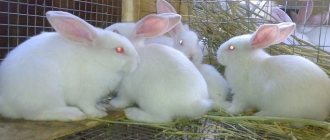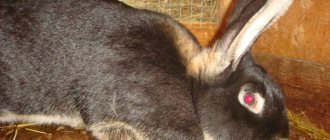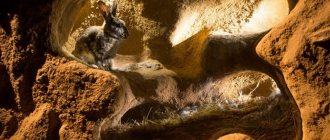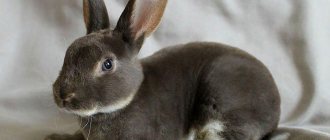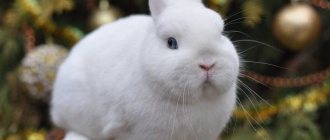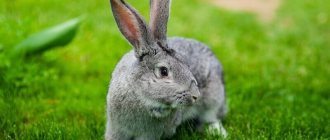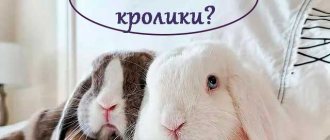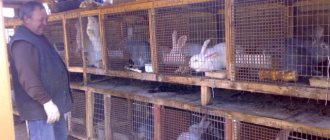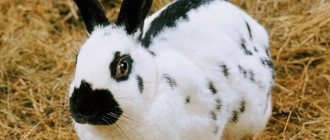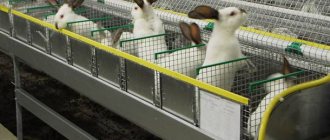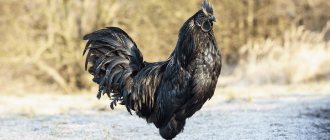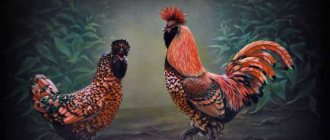The albino rabbit is especially highly prized. This is explained by the fact that in such animals, during the breeding process, the gene responsible for white color is more often suppressed by genes for gray and black color. Accordingly, it is quite difficult to breed completely snow-white animals. But, nevertheless, German and Belgian breeders succeeded in this at one time. And proof of the success of their work is the white giant breed.
White rabbit is more valuable
White giant - rabbit with red eyes
The white giant rabbit is one of Flandre's relatives. The white giant is an albino with red eyes, a popular meat-skin breed in Russia. The article contains details about the White Giant, a little about popular and rare breeds of pure white rabbits.
Within the White Giant breed, two selection groups (offspring) are known.
Offspring is a zootechnical term, not a dirty word, see crossbreeding. The term denotes a split within one breed into two or three groups adapted to different breeding conditions. Look about giants, or more precisely about the breeding of German and Russian white giants.
- The white giant is a German offspring (since 2012 the breed has not been maintained in its pure form).
- The White Giant is a Russian spawn. In our article the story will be about the domestic selection of this breed.
Photo. Rabbits White giant of domestic selection
What breeds of rabbits are bred in the Moscow region
Different types of rabbits have their own nuances in terms of immunity and care requirements. Recommended breeds for breeding may vary depending on the region. For example, in central Russia the climate is quite warm, but summers are not hot. For this reason, almost any breed can be bred in the Moscow region. The temperate climate makes it possible to achieve the highest performance indicators for meat, down, and fur species.
You can find suitable rabbits in this region on livestock farms and large, industrial farms, “Ruza-MIAKRO”, “KFH Shcherbakova A.E.”, “LPH of the Ivanov family” and the like.
History of breed selection
White giant, a breed of albino rabbits. As a result, scientists in Germany and the USSR, using different methods, obtained a breed with the same name “White Giant”, outwardly almost indistinguishable rabbits, albinos with red eyes.
Albinism is a genetically determined absence of the melanin pigment in a rabbit's body. The absence of melanin in the body gives:
- wool - white;
- the pupils of the eyes are red or blue;
- claws - colorless coloring.
For what purpose were breeds of albino rabbits bred?
White color has long been a fashionable color, which explains the large number of identical breeds in different countries. Genetic mutation - albinism is caused by breeders using random or controlled inbreeding. The result is confirmed by purebred crossing. The peculiar coloring unites the albino breeds and makes them indistinguishable upon a quick examination. The white giant rabbit breed is very similar in appearance to other white breeds. Rabbits are distinguished by body type, weight standard, and eye color.
The White Giant breed is supported in 7 breeding breeding centers in the Russian Federation (Moscow - 2 breeding stations, one each in Perm, Krasnodar, Tula, Ulyanovsk). The fate of the loudspeaker in Tatarstan is unknown.
Breed standards
- The body is elongated, the bones are strong (tribe), thin (for fattening),
- The head is round, the ears are light (15–18 cm), erect;
- Chest, girth more than 37 cm (tribe), less than 36 cm (fattening), a dewlap is characteristic;
- The back is long, medium wide, straight.
- The sacrolumbar part is wide (breeding, or fattening), narrow (marriage).
- The croup is wide and rounded.
- The legs are long, straight, strong and not thick.
- Eyrisomny type of constitution (simply athletic body type) - suitable for breeding.
- The rabbit has a mesosomal build (medium athletic build), thin bones, and is suitable for fattening.
- A white giant with a leptosomal body type is sent for fattening.
Preservation of the White Giant breed
Since rabbits can very quickly lose their breed qualities, if there is incorrect breeding classification, errors in feeding and maintenance, you need to constantly be on the alert and ensure that the breed is kept clean. They monitor the most obvious deviations from standards, which are easy to detect even for a non-professional. They look at two main parameters:
- skin defects (fur is a genetically fixed characteristic of the breed),
- slaughter weight (a decrease in the weight of a rabbit after slaughter is evidence of the degeneration of the breed).
Specific examples of deviations from the White Giant breed standard:
- uneven hairline;
- the appearance of fluffy fur (non-standard fur color);
- reduction in early maturity and slaughter yield in 90-120 days by more than 56-59%.
If the live weight of a rabbit before slaughter is 5.1 kg, then the carcass should not be less than 3.0 kg. this is a signal that the breed is reducing its potential.
Rabbit breeds for the Kaluga region
"Yukhnov-Krol" is a famous plant in the Kaluga region for the production of rabbit meat. Breeds are purchased mainly from abroad and bred on the territory of the enterprise. Species such as French Hiplus, California rabbit, and Soviet chinchilla are bred here.
In addition, the APANYUK & Co rabbit breeding farm operates in the region. Here they professionally breed rabbits of various types, maintaining the purity of the blood of the breeds. At this enterprise you can purchase breeding specimens of the White Giant, Californians, Burgundy rabbits, Ram, Chinchilla, Risen and the like.
Cages for the White Giant, sizes
This breed needs a large cage space; a wooden cage is recommended. It is better to do it yourself at home. You create the structure of the cage yourself. It is important to know the floor dimensions. This is the most important indicator; the larger the breed, the larger the cage. On the other hand, unreasonably large cages are an overconsumption of building materials. For large breeds (Gray giant, White giant, Flanders, Soviet chinchilla), with an average live weight of 6–8 kg, it is necessary to make the following sizes:
- length 1200–1300
- width 600–700 mm,
- height 35-40 cm
Or, according to technological design standards, the floor area is calculated based on the minimum requirement of a large rabbit - 0.2 m 2 per kg of animal body weight. If the rabbit weighs 6 kg, then the floor area of the cage will correspond to 1.2 m2.
It is necessary to periodically maintain cleanliness in the cage. Cleaning cells 2-3 times a week. Every six months the cells must be disinfected by whitewashing with lime.
Breeding the white giant breed
The white giant matures early enough for mating and breeding. This procedure will not cause any difficulties. This is one of the best breeds for breeding. Those who breed white giants consider female rabbits to be responsible mothers with good fertility. One litter - up to 8-9 rabbits. Read about female pregnancy and litter here. Female rabbits are usually placed with males at the age of six months. For breeding, large representatives are selected, without defects, defects, and with strong limbs. Mating usually lasts a couple of hours, sometimes faster. After 5-6 days, a repeat control procedure is performed. In a situation where the female does not allow the male to approach, therefore, fertilization has already been done. Baby rabbits, when they are 2 months old, are separated from their mother and begin to feed on their own.
Breeding
Puberty in females and males of albinos occurs 4 months after birth. But, most breeders agree that they should be allowed to mate no earlier than the 6th month. Sexual hunting occurs regularly in rabbits.
Female rabbits produce up to 10 babies per litter. One female has about 6 litters per year. Moreover, she is ready for repeated mating within 2 days after the birth of the offspring. Female rabbits are distinguished by their developed maternal instinct. They constantly warm the young, they do not have the habit of eating newborn rabbits. In addition, 240-250 g of milk is produced in the mammary gland of a female rabbit per day, which is quite enough to feed the offspring. But, such a volume of colostrum is formed only if the diet is properly selected.
Rabbits are left with their mother until they are 2 months old. After this, the babies are weaned.
A large number of domestic specialized enterprises are engaged in breeding albino rabbits. Such pets are not uncommon in small farms. The reason for this is the snow-white skins of animals, which are highly valued by fur factories, as well as dietary meat with high taste. But when breeding white giants, you should first familiarize yourself with the peculiarities of their maintenance and feeding.
Features of feeding giants
The white giant grows quite well on regular feed. The basis of the diet is crushed grain or mixed feed. About fattening rabbits.
- Barley, grain crops (pearl barley, barley) cereals. In the form of grain, it is a valuable fodder crop rich in vegetable protein and carbohydrates in the form of starch. In the structure of the diet of fattening rabbits, up to 23% is from other types of food.
- Wheat. Grain contains protein, carbohydrates, and fats. Valuable fodder crop for rabbits. In the structure of the diet of fattening rabbits up to 20%
- Sunflower cake. They are seeds after squeezing sunflower oil out of them. In the structure of the rabbit's diet it accounts for up to 13%.
- Bran. A coarse product of grain processing, rich in nutrients. In a rabbit's diet, this product can be up to 10% of the total diet.
- Alfalfa flour, in the form of granules. Can be replaced with fresh alfalfa hay. For rabbits it is used as a vitamin supplement and as a fiber-rich product. The structure of a rabbit's diet contains up to 34% of hay or alfalfa pellets.
Feed additives for the diet of giant rabbits
You can read about feed additives that are registered in Russia, here are some that are not registered or the most common.
- Chalk. Source of calcium, potassium, phosphorus, sodium, silicon. Used to normalize calcium levels in fast-growing animals, to prevent rickets, dystrophy, and bone deformations. Its amount in the diet is small, no more than 0.5%.
- The white giant, despite the fact that it is a herbivore, eats fish meal well, rich in macro and microelements. Its content in the diet should not exceed 1%.
- As a desirable substance, feed yeast is added - a source of B vitamins, amino acids and other useful substances.
- Premix (BVMK or BMVD) protein-vitamin-mineral concentrate or supplement. Several types are produced for rabbits at home: “Ushastik” and “Zdravur”. For rabbits, the farm produces premix brand P-90 and others. They are mixed into the feed in a certain ratio, indicated on the packaging.
- Table salt. In small quantities it is necessary as a trace element and to improve the palatability of the feed.
White giants, rabbits of famous breeds
There are about twenty breeds of white rabbits in the world. Not color varieties that meet the standard, but white albinos, which were bred by fixing the albinism mutation. The main breeds familiar to Russian, Ukrainian, and Belarusian rabbit lovers are listed below.
New Zealand white breed of giant rabbits
Photo. New Zealand White (NZB) rabbit. Weight 4.1 - 5.4.
Hungarian rabbit White Pannon
About Pannon rabbits, find out if they are a hybrid or a breed or a line, or maybe a cross? One of the differences between the pannon is that these rabbits have a skin that fits tightly to the body. To do this, take the skin of a Pannon rabbit and a white giant (for example) in the back area. Pannon is very good for fattening, but I would not recommend it for keeping in Russia. The reason is the lack of methodological support for the breed. It's easy to run into charlatans.
Photo. Hungarian rabbit is a white giant with red eyes. See more details here
Vienna white, albino rabbit
Read about the Vienna Blue and its albino sibling. In fact, these are the same breed, just different colors. Unlike many other albino breeds, he has blue eyes. There is also a wild color (agouti) of the blue Viennese rabbit.
Photo. Viennese white rabbit. Albino with blue eyes. Weight 3.5-5.25 kg.
Turkish giant Angora. white albino giant
About the Angora breed group, especially about the specific skin diseases that the Angora rabbit suffers from.
Photo. White giant from Turkey, weight 5.5-12.0 kg
Czech White, aka Czech Albin
Photo. Czech Albin or Czech White. Albino with red eyes, weight 4.0-5.0 kg
French Blanc de Bousquet albino giant rabbit
Photo. Blanc de bousquet. White giant from France. Weight 5.0-7.0 kg
Russian breed of giant rabbits White Pukhovaya
Photo. White downy breed. Fluffy giant white. Weight 4.0 kg
Source
Down and fur rabbits
Down and fur breeds are bred to produce high quality fur, fluff or pelt. They require painstaking care, because these animals often stain their valuable fur. A description of the breeds of downy rabbits that are in great demand among breeders is presented below.
Photo of an Angora rabbit
- The Angora rabbit is a famous species. Highly prized for its excellent wool. The body is small, the legs are strong. The head is medium in size with short ears. Weight approximately 3-5 kg. The coat is long, very thick, white, gray, beige, although other colors are allowed according to the standard. The wool is usually clipped or combed. Cut from one individual - 200 g.
Photo of a Rex rabbit
White fluffy breed of rabbits
This category also includes rabbits such as the White Giant, Ram, etc.
Albino rabbit
The albino rabbit is especially highly prized. This is explained by the fact that in such animals, during the breeding process, the gene responsible for white color is more often suppressed by genes for gray and black color. Accordingly, it is quite difficult to breed completely snow-white animals. But, nevertheless, German and Belgian breeders succeeded in this at one time. And proof of the success of their work is the white giant breed.
Decorative breeds of rabbits
Decorative rabbits are bred in apartments and private houses as pets.
Photo of Butterfly rabbit
- Butterfly is an interesting, popular type of domestic rabbit. Weight approximately 4.5 kg. They have a small body. The head is disproportionate to the body, with even ears. The back and chest are wide, the legs are long. The fur coat is downed, very soft, light in color, but there are also black spots. And the nose and ears are usually completely black. During pregnancy, a female rabbit gives birth to 8 animals.
Photos of Vienna Blue Rabbits
- The Viennese blue rabbit is a small animal up to 4.5 kg. The bones are small and regular in shape. The head is not large with round cheeks and small ears, rounded at the ends. The paws are straight and strong. The fur coat is very thick, rich gray with a blue tint. There are about 8 cubs in one litter.
Photo of a Ram rabbit
Also in this category it is worth including such breeds as Rex, Ermine, and Soviet Marder.
Origin story
Pure white rabbits are quite rare in various breed lines. It is extremely difficult to get one like this through the selection process. Breeding a breed for which albinism is a characteristic feature is an even more difficult task. But this is precisely the goal that the breeders of one of the German institutes set for themselves. This direction of work was dictated by the needs of the fur industry, in which white fur was especially highly valued.
Albino rabbits of the Flanders breed (Belgian giant) were selected as the basis for the breed line over a period of time. These animals are predominantly gray in color, but in some individuals, due to genetic characteristics, the synthesis of melanin, which is responsible for this color, is disrupted. As a result, a snow-white rabbit with red eyes is born. It was these animals that German breeders purposefully selected to found a new breed. Over time, the characteristic became firmly established in animals and began to be passed on to subsequent generations. But with the development of the new breed, a number of negative aspects also appeared, including:
- weak immunity;
- extremely low fertility;
- inability to cope with harsh climatic conditions;
- weak endurance.
Breeders from Belgium managed to partially solve such problems, to which almost all the livestock were transported in 1928. But all the negative aspects in the breed line were finally corrected by breeders from the USSR. To increase the fertility of animals, the rate of their development and resistance to local harsh climatic conditions, they were crossed with representatives of the gray giant and chinchilla breeds.
As a result, crossing other albinos with a rabbit of Belgian origin yielded results, and the white giant firmly established itself on the territory of the Soviet Union. But, at the same time, the size and weight of the living creatures that she inherited from the Flanders suffered to a certain extent.
Downy breeds of rabbits
Downy breeds are specially bred so that the skin for the most part consists of downy hair. Compared to other animals, rabbit fluff is much softer, more uniform and of better quality.
Angora
Downy Angora rabbits came to Europe from Turkey and for a long time were considered exotic, worth their weight in gold. Although the animals are not large, the volume of fluff reaches 92%, so even with monthly haircuts they resemble fluffy balls. You can get up to 1.5 kg of fluff per year from a large individual.
Photo: kpc.spbstu.ru
French Angora
These are already miracles of European breeders who managed to make the breed larger and denser. It is easier to care for the animals because they do not have long fluff underneath, which must be constantly trimmed in order for the rabbit to move normally. The wool practically does not mat, so it is easier to comb French Angoras.
Photo: nashi-kroliki.com
White down
The domestic breed is ideally suited to mid-latitudes and cool regions because it does not tolerate heat well. Downy hairs are very light and elastic, making up up to 95% of all fur. A rabbit weighing up to 5 kg produces about 750 g of fluff per year.
Photo: hmoob.in
Satin
Satin rabbits are not as fluffy as other downy varieties, but the structure of their down is fundamentally different. The shining silky fur resembles satin fabric - it is very thin, and due to this it is much more delicate and soft.
Photo: tailstown.com
Arctic fox
Another domestic, but this time a very old breed, easily adapts to different climatic conditions. Rabbits are small, so they produce up to 250 g of fluff, but they are completely unpretentious in food, almost never get sick and are very hardy.
Photo: sichovka.ru
Hard cheese varieties: names, photos and descriptions (list)
Description of the breed
White giants have an impressive appearance. They inherited their large dimensions from Flanders, who is considered the world record holder in terms of weight.
White giants have an impressive appearance
The average weight of albinos is from 3.5 to 6 kg. The large weight is complemented by body length, which often reaches 60 cm. The main body features of the breed include:
- elongated dense body;
- wide chest, reaching 40 cm or more in girth behind the shoulder blades;
- elongated, large head;
- rounded, straight ears, the length of which is 15 cm;
- tightened, strong paws, which are set quite widely relative to the body, and therefore the animals can better handle a large body.
As for color, all purebred offspring without exception have fur that is ideally white. Certain inclusions, a yellowish or grayish tint of fluff can be traced only in those individuals that were born in the process of crossing with other varieties of rabbits.
Completely red eyes of an animal are also a characteristic feature of a violation of melanin synthesis. Due to the absence of such pigment, the iris becomes completely colorless. Therefore, the blood vessels located underneath are easily visible from the outside. They provide the red color to the eyeball.
In addition to the obvious signs of the breed line’s exterior, there are two more features that deserve attention:
- Poorly developed fur on the limbs. This characteristic, combined with a large body mass, implies certain inconveniences in keeping animals. If a rabbit is kept in an enclosure with a slatted floor, it will quickly develop corns, which are quite difficult to get rid of on your own. Therefore, it is better to make the flooring in the cage from solid materials.
- Dewlap in females. This element of appearance does not appear in all animals. This is why, after comparison, many breeders confuse it with a double chin. Perceiving this as a consequence of overfeeding, they begin to sharply reduce the caloric content of their diet. In fact, such formation has nothing to do with obesity and, on the contrary, is a sure sign of the rabbit’s excellent health.
Meat rabbits
Meat breeds of rabbits are bred on large and small farms. They produce a lot of delicious, healthy, dietary meat, which is why the best meat breeds are highly valued.
Photo of California rabbit
- The California rabbit has a short body. The skeleton is light, but formed correctly. The muscles are well developed. Average weight – 4-5 kg. The legs are short but strong. The head is medium with small, erect ears up to 11 cm. The nose is hump, the eyes are scarlet. The coat is thick and white over the body, but the ears, paws, nose and tail are always dark. During pregnancy, the female gives birth to 8 rabbits.
Photo of the Soviet chinchilla rabbit
Photo of Black-brown breed of rabbits
Productivity
The large weight of white giants is the main reason that such animals are bred to produce valuable dietary meat. The yield of rabbit meat from one head, 65 days old, is 47%. If proper feeding is observed, this figure increases to 59-60% by the 275th day of the animal’s life. At the same time, livestock meat products are in high demand due to their delicate texture and excellent taste.
There is a high demand for the skins of this breed of rabbits
But of course, such rabbits are raised not only for their meat productivity. There is a high demand for the skins of this breed of rabbits. They are distinguished by high density, silkiness and softness of the pile. A wide range of different clothing items and accessories are produced from such raw materials.
Reference. According to the results of the research, it was revealed that on an area of 100 sq. mm of rabbit skin grows an average of 18-22 thousand hairs. At the same time, there are about 20-23 downy hairs for each core villus.
Rabbits for breeding in the Tula region
In the Tula region, as in the Moscow region, the climate is pleasant and moderate. It is ideal for breeding rabbits, but where can you buy them? Many farms in this area breed rabbits. Among the most famous are the Zazino agricultural farm and the Giant Rabbits private farm.
Important! When any danger appears, the rabbit tries to immediately run away. But if this fails, he may begin to defend himself. With a blow from its strong paws, this small animal is capable of killing a small predator![/su_box]
Feeding
The diet of rabbits can and should be varied. Only in this case will it be possible to provide the animal’s body with all the nutrients and vitamins necessary for normal functioning.
Throughout the year, the main component of the white giants’ menu should be high-quality hay. Such food normalizes the functioning of the gastrointestinal tract of animals, promotes the growth of muscle mass due to the content of large amounts of protein and vitamins. But when feeding rabbits with such food, a number of points must be observed:
- Feed your pets exclusively fresh hay;
- You should periodically check supplies for the presence of mold and signs of rotting, and if they are found, exclude such food from the rabbits’ diet;
- harvesting must be carried out on lawns and clearings, as far as possible from the roadway and industrial enterprises.
In the spring and summer, rabbits must be fed fresh vegetation. Meadow clover, leaves and stems of dandelions, burdock, and sow thistle are beneficial for their body. You can also collect young nettles. But collecting herbs from a meadow is allowed only if the owner of the animal knows exactly what each specific species looks like. Otherwise, you can mistakenly prepare poisonous greens, which can lead to a number of intestinal diseases.
To avoid this risk, use fresh green food from plants growing in the garden. Rabbits and adult livestock happily eat the leaves of sunflowers, tomatoes, melons (melon, watermelon, zucchini), and pepper.
It is advisable to include the following vegetables and fruits in your diet:
You can also feed banana pulp and skins to animals. But their consumption must be limited, as in large quantities they cause stomach upset.
Many livestock owners use foliage and branches of various trees when feeding. But the choice of such food should be approached responsibly. The leaves and shoots of apple, pear, and acacia have a good effect on the digestion and health of rabbits. But you should not feed the animals oak greens. It can cause diarrhea in them.
Another useful component of feeding white giants is the so-called vinaigrette. This mixture is prepared as follows:
- Fresh grass and tree foliage are chopped (not very finely) into an enamel bowl.
- Cut waste from vegetables and fruits is also added there.
- All this is thoroughly mixed and poured with boiling water.
- The entire contents of the container are boiled for two hours, filtered and the food is allowed to cool.
Rabbits eat this food with pleasure. It is rich in nutrients, vitamins and significantly enhances furry growth.
